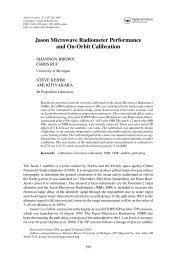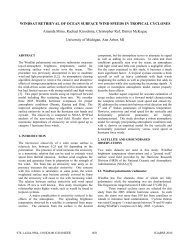Sensitivity of the Kurtosis Statistic as a Detector - Remote Sensing ...
Sensitivity of the Kurtosis Statistic as a Detector - Remote Sensing ...
Sensitivity of the Kurtosis Statistic as a Detector - Remote Sensing ...
Create successful ePaper yourself
Turn your PDF publications into a flip-book with our unique Google optimized e-Paper software.
DE ROO et al.: SENSITIVITY OF THE KURTOSIS STATISTIC 1943<br />
V. L IMITS OF DETECTION<br />
A. Blind Spot and False Alarm Rate (FAR)<br />
If <strong>the</strong> kurtosis becomes 3, <strong>the</strong>n, in spite <strong>of</strong> <strong>the</strong> presence <strong>of</strong><br />
RFI, <strong>the</strong> algorithm will fail to detect it. This indicates a blind<br />
spot in <strong>the</strong> algorithm. Two conditions are possible in which<br />
<strong>the</strong> kurtosis becomes 3: S =0or d =1/2. The first condition<br />
corresponds to <strong>the</strong> absence <strong>of</strong> RFI, while <strong>the</strong> second is an<br />
algorithm blind spot. It is worth noting that practical radars tend<br />
to operate with duty cycles well below 50%, and so radiometers<br />
will generally not be subject to this problem. None<strong>the</strong>less, this<br />
result is somewhat surprising given <strong>the</strong> obvious differences<br />
between <strong>the</strong> 50% duty cycle and Gaussian pdfs in Fig. 5. This<br />
is because <strong>the</strong> kurtosis is just one more parameter that describes<br />
<strong>the</strong> pdf. A more complete description <strong>of</strong> <strong>the</strong> pdf requires more<br />
moments <strong>of</strong> <strong>the</strong> pdf.<br />
In light <strong>of</strong> <strong>the</strong> variance in R even in <strong>the</strong> absence <strong>of</strong> RFI,<br />
<strong>the</strong>re will be a range <strong>of</strong> RFI around R =3± zσ R0 for some z<br />
determined by <strong>the</strong> desired FAR for which <strong>the</strong> kurtosis algorithm<br />
is blind. To determine this region <strong>of</strong> blindness, we solve (20) for<br />
<strong>the</strong> duty cycle, i.e.,<br />
d =<br />
3<br />
2 S2<br />
(1 + S) 2 R − 3(1 + 2S) . (22)<br />
Provided that <strong>the</strong> number <strong>of</strong> independent samples N is sufficiently<br />
high to invoke <strong>the</strong> normal distribution <strong>of</strong> <strong>the</strong> kurtosis R,<br />
<strong>the</strong> relation between a specified FAR and <strong>the</strong> threshold values <strong>of</strong><br />
<strong>the</strong> kurtosis R tha =3+z a σ R0 and R thb =3− z b σ R0 is given<br />
by FAR = FAR a + FAR b , where<br />
FAR a,b = 1 2<br />
(<br />
1 − erf(z a,b / √ )<br />
2)<br />
(23)<br />
and <strong>the</strong> subscripts a and b refer to <strong>the</strong> tail <strong>of</strong> <strong>the</strong> distribution<br />
“above” and “below” <strong>the</strong> RFI-free kurtosis mean value <strong>of</strong> 3.<br />
Fig. 6 illustrates <strong>the</strong> region <strong>of</strong> sinusoid amplitude and duty<br />
cycle in which <strong>the</strong> signal will not be detected by <strong>the</strong> kurtosis for<br />
a given number <strong>of</strong> independent samples and FAR. The kurtosis<br />
is blind at a 50% duty cycle. In this example, <strong>the</strong> FAR is nearly<br />
symmetric (FAR a = FAR b ) because N is sufficiently large to<br />
invoke <strong>the</strong> normal distribution <strong>of</strong> R and z = z a = z b .For<strong>the</strong><br />
curves presented in Fig. 6, zσ R0 =0.03, which corresponds<br />
to an arbitrarily chosen FAR =4.4% for N = 108 000. Under<br />
<strong>the</strong>se conditions, <strong>the</strong> 100% duty cycle (CW) limit <strong>of</strong> detection<br />
is S = −7.84 dB, corresponding to T ps =99K, <strong>as</strong>suming an<br />
RFI-free T sys = 600 K. The limit <strong>of</strong> detection for very short<br />
duty cycle RFI is lower. For example, <strong>the</strong> ∼1% duty cycle <strong>of</strong><br />
ARSR-4 radars should be detectable at −18.4 dB (8.3 K), and<br />
<strong>the</strong> ∼0.1% duty cycle <strong>of</strong> ARSR-1 radars should be detectable<br />
at S = −23.4 dB (2.7 K) at FAR =4.4%. ForFAR a = 10%,<br />
<strong>the</strong> ARSR-1 detectable limit is S = −24.4 dB (2.2 K). Thisis<br />
very close to <strong>the</strong> ideal radiometric uncertainty since NE∆T =<br />
T sys / √ N =1.8 K.<br />
B. Probability <strong>of</strong> Detection<br />
When <strong>the</strong> number <strong>of</strong> samples N is sufficiently large to<br />
describe <strong>the</strong> distribution <strong>of</strong> <strong>the</strong> kurtosis <strong>as</strong> having a Gaussian<br />
Fig. 6. <strong>Kurtosis</strong> blindness to pulsed sinusoidal RFI, with zσ R0 =0.03,<br />
which is <strong>the</strong> 4.4% FAR for Bτ = 108 000. The pulsed sinusoidal RFI with<br />
duty cycle and power between <strong>the</strong> R =3± zσ R0 curves are not detectable.<br />
At any power level, a 50% duty cycle is undetectable. The limit <strong>of</strong> detectability<br />
for very short pulsed RFI is much lower than that for CW RFI and approaches<br />
NE∆T.<br />
distribution with mean R and standard deviation σ R , we can<br />
predict not only <strong>the</strong> FAR but also <strong>the</strong> probability <strong>of</strong> detection<br />
(PD) for a given threshold value <strong>of</strong> kurtosis R th , strength S, and<br />
duty cycle d <strong>of</strong> pulsed sinusoid RFI. Considering <strong>the</strong> blind spot<br />
at d =1/2, <strong>the</strong> PD for RFI with d1/2 (e.g., CW RFI) will be denoted <strong>as</strong> PD b because<br />
we expect R to be below 3. These probabilities <strong>of</strong> detection are<br />
given <strong>as</strong><br />
PD a,b = 1 2<br />
( ( (Rtha,b<br />
1 ∓ erf − R(S, d) ) / √ ))<br />
2σ R (S, d) .<br />
(24)<br />
Figs. 7 and 8 show <strong>the</strong> receiver operating characteristic charts<br />
for 0.1% and 1% duty cycles, respectively, while Fig. 9 shows<br />
<strong>the</strong> same for 100% duty cycle, for a fixed N = 108 000. The<br />
performance <strong>of</strong> <strong>the</strong> algorithm is much better at a low duty cycle.<br />
C. Dependence <strong>of</strong> Detection <strong>of</strong> RFI on System Parameters<br />
For a duty cycle d that is small, <strong>the</strong> sinusoid amplitude A<br />
must be substantial to obtain a particular level <strong>of</strong> interference.<br />
The digitizer must not clip this short duration pulse, or we<br />
will effectively reduce <strong>the</strong> interference to <strong>the</strong> point where it<br />
remains present but is not detectable. If we arbitrarily consider<br />
<strong>the</strong> minimum T ps which is unambiguously detectable without<br />
using <strong>the</strong> kurtosis statistic <strong>as</strong> being equal to, say, 10NE∆T, <strong>the</strong>n<br />
<strong>the</strong> digitizer should not clip <strong>the</strong> signal for S





